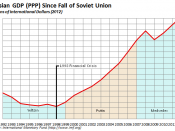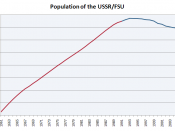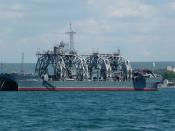N/A N/A
In August of 1991, the collapse of the communist system in the USSR and it's neighboring republics occurred. Out of the smoke emerged fifteen new republics and a union known as the Commonwealth of Independent States. These new regimes faced formidable obstacles. The collapse brought massive inflation which in turn forced the economy into a spiraling decline and a state of almost worthless value. Many people were quick to point the finger at their communist past, and even more eager to lay blame. Traditional communist ideology was to 'provide for every individual an equal amount of goods and services, thus creating a state of equality amongst the populous' (Leveler, 16). Many people felt as if their current hardships could be blamed on the communists and their economic policies, specifically their 'Core-Periphery' plan.
The communist sponsored 'Core-Periphery' economic policy that was evident in Russia was quite simplistic in nature.
The theory, traditionally used to describe inter-continental trading and production, was adapted for use in the Russian economic zones. The theory was as follows; Areas which surround the capital (core region), usually rich in one material or another, would be used for the extraction of raw materials. These materials would then be shipped back to the capital in order to be manufactured into goods. From there, the manufactured products would be shipped back to the surrounding regions (periphery region) for resale. The citizens of Russia were surviving on this system, but barely. The Core-Periphery policy was not efficient, nor effective, for usually a product needed on one side of the federation, was produced at the other end. Factors such as transportation costs and adequate use of human resources was very inefficient and cost-consuming. Strong influences from the world urged Russia to make the transition into the market-oriented economy. This seemed...


